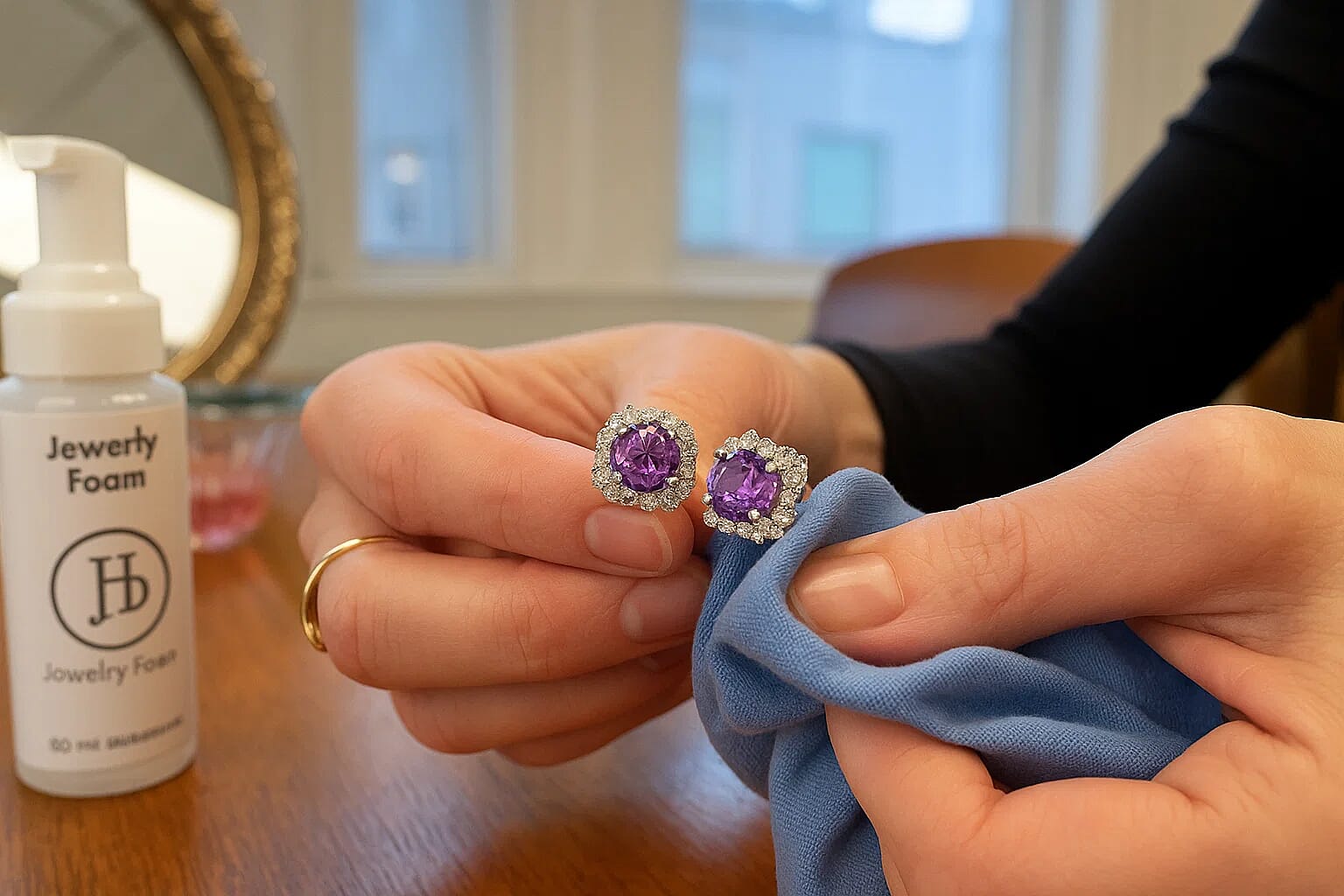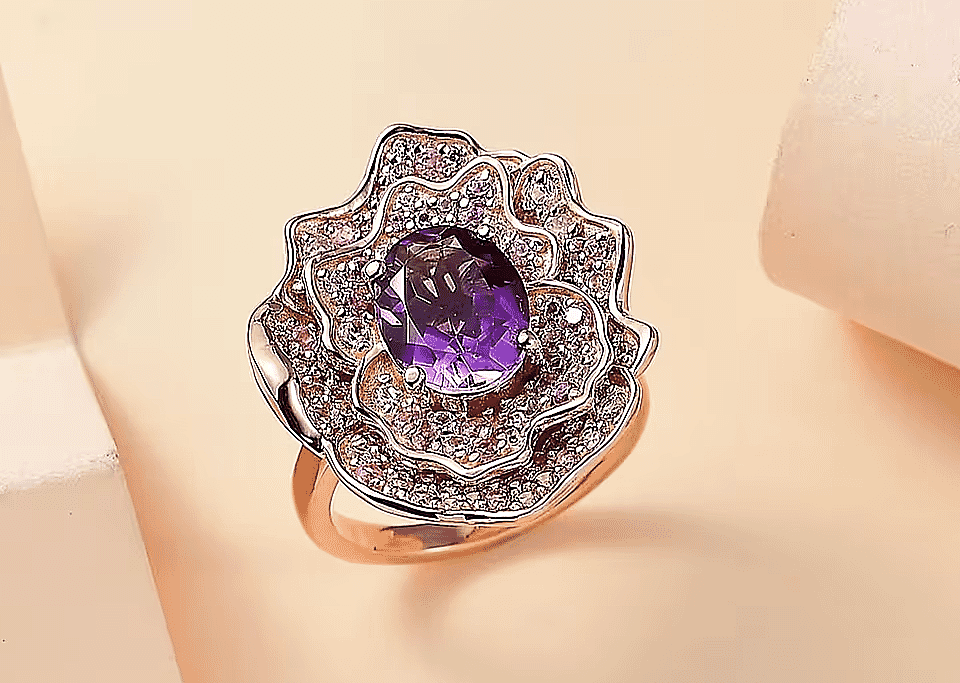
MOROCCAN AMETHYST GEMSTONE
Moroccan amethyst is a highly sought-after gemstone, cherished for its deep purple to reddish-violet hues and exceptional brilliance. Found in the mines of Morocco, this variety of amethyst is celebrated for its vibrant saturation and remarkable clarity, making it one of the most prized sources of amethyst in the world. Whether crafted into rings, pendants, or earrings, Moroccan amethyst brings a regal touch of elegance to any jewelry collection.
TABLE OF CONTENTS
IMPORTANCE
What Makes Moroccan Amethyst So Special?
Amethyst, a gemstone revered for its captivating purple hues and mystical properties, is found across the world, each with unique characteristics attributed to its origin. Moroccan Amethyst is prized for its deep and vibrant violet colors, often showing red flashes under incandescent light. This particular variety of amethyst is known for its superb clarity and unique inclusions that can resemble artful patterns, making each gem uniquely captivating. Its ability to maintain color intensity even in smaller sizes also makes Moroccan Amethyst particularly desirable among collectors and jewelry enthusiasts.
VALUE
Determining Moroccan Amethyst's Value
COLOR
The most valuable Moroccan Amethysts possess a vibrant, deep purple hue, often sought without any color zoning. Ideal specimens exhibit a uniform color distribution that enhances their overall appeal and worth, making color the foremost criterion in evaluating these gems.
Clarity
Clarity in Moroccan Amethyst refers to the absence of visible inclusions. Stones that are clear and free from any impurities or internal defects are highly prized. High clarity ensures a cleaner appearance and better light passage, increasing the gemstone's desirability and value.
Cut
A well-executed cut is crucial for Moroccan Amethyst, as it maximizes the stone's inherent brilliance and depth of color. Expert cutting not only highlights the gem's best optical qualities but also minimizes any apparent inclusions, significantly enhancing its market value.
Carat
Larger Moroccan Amethysts are rare, especially those that maintain deep color and clarity. Consequently, size significantly influences their price, with larger, flawless specimens commanding premium rates in the gemstone market. Carat weight directly correlates with the value, making bigger amethysts more collectible.
Is Moroccan Amethyst a Birthstone?
Amethyst is the traditional birthstone for February, recognized for its beautiful purple shades that range from deep violet to pale lavender. As part of the modern birthstone list, it is esteemed not only for its aesthetic appeal but also for its purported abilities to calm the mind and enhance emotional intelligence. This gem is a favorite for jewelry, offering a touch of elegance and serenity to those born in February.
Storage
Caring for Moroccan Amethyst
Caring for Moroccan Amethyst involves basic gemstone maintenance to ensure its longevity and luster. It should be kept away from direct sunlight and high temperatures to prevent color fading. Cleaning should be done using mild soap and lukewarm water with a soft brush. It is also advisable to store Moroccan Amethyst away from harder gems to avoid scratches.

IDEAL CHOICE
Who Can Wear Moroccan Amethyst?
Amethyst is the birthstone for February and is believed to bring clarity of thought and emotional balance, making it an excellent choice for those born in that month. However, its universal appeal and positive properties make Moroccan Amethyst a suitable choice for anyone looking to add a touch of elegance and metaphysical benefits to their jewelry collection.

Difference
How Does Moroccan Amethyst Compare to Other Gems?
When comparing Moroccan amethyst, purple sapphire, and purple garnet, key factors like color intensity, rarity, durability, and value come into play. Moroccan Amethyst often displays a deep violet hue, rich yet accessible. In contrast, Purple sapphire, a rarer and more valuable variant, offers intense, vivid purple shades with occasional blue or red undertones, making it highly sought after. Purple Garnet, especially varieties like Rhodolite, ranges from raspberry to purplish-red, displaying a unique vibrancy less common in the purple gemstone spectrum. While Moroccan Amethyst is more readily available and affordable, the rarity of Purple Sapphire and Purple Garnet enhances their collectability and value.
OVERVIEW
What Does Moroccan Amethyst Mean?
This gemstone is known to promote spiritual growth and inner peace, making it a favored choice for meditation and mindfulness practices. Believed to resonate with the crown and third eye chakras, Moroccan Amethyst enhances intuition, fosters clarity, and helps in deepening one’s connection to the spiritual realm. It is also valued for its protective qualities, warding off negative energies and promoting emotional balance, thereby acting as a stabilizing force in times of stress and transformation.
TREATMENT
Moroccan Amethyst Treatment
Moroccan Amethyst stands out as a purely natural gemstone, celebrated for its untouched and unenhanced beauty. This gem preserves its vibrant, deep purple coloration without the need for any treatments, embodying the true essence of nature. Its authenticity makes it particularly valued among collectors and enthusiasts who prefer gems in their most original form.
ORIGIN
Where Does Moroccan Amethyst Come From?
Our Moroccan Amethyst from the remote Boudi region in the Atlas Mountains of Southern Morocco, a gem only recently introduced to the global market.
The story of Moroccan Amethyst begins in the early 1990s, when a group of nomads seeking shelter from a storm in the mountains discovered mysterious purple crystals washed up by the rain. Initially collected as trinkets for trade, these crystals continued to be gathered by hand for decades. It wasn't until 2010 that their true nature was confirmed as amethyst by the Gemological Institute of America, sparking interest in their potential for mining and introducing these unique gems to the world.
Moroccan Amethyst Facts
MOHS HARDNESS
7
COLOR
Displays deep violet hue with red flashes.
TREATMENT
None.
ORIGINS
Atlas Mountains, Morocco.

FAQs
Q. What makes Moroccan Amethyst different from other types of amethyst?
A. Moroccan Amethyst is distinctive for its deep purple hues and the natural, unenhanced state in which it is often found, making it a pure expression of this beloved gemstone.
Q. Is Moroccan Amethyst considered a good investment?
A. Yes, due to its natural beauty and rarity, Moroccan Amethyst is considered a valuable addition to any gemstone collection, potentially increasing in value over time.
Q. Can Moroccan Amethyst be used in jewelry?
A. Absolutely! Moroccan Amethyst is durable and vibrant, making it an excellent choice for various types of jewelry, from rings and earrings to pendants and bracelets.
Q. What are the metaphysical properties of Moroccan Amethyst?
A. Moroccan Amethyst is believed to promote clarity of mind, enhance intuition, and help in spiritual growth. It's also associated with protection from negativity and fostering emotional balance.
Q. How should I care for my Moroccan Amethyst to keep it in good condition?
A. Keep your Moroccan Amethyst away from harsh chemicals and extreme temperatures. Clean it gently with soapy water and a soft brush and store it separately to avoid scratches.